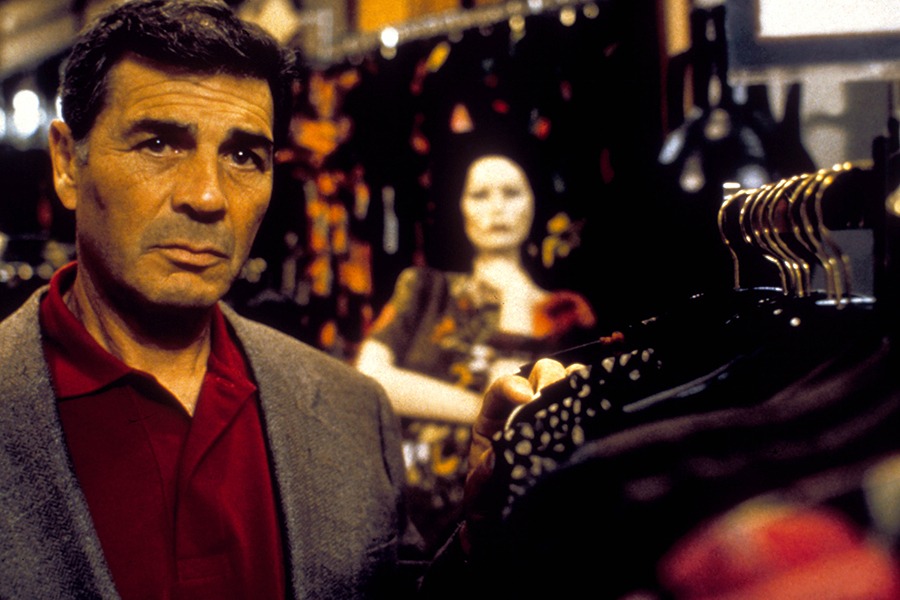Actor Robert Forster talked tough. His hard consonants and elongated vowels made him perfect for the role of streetwise bail bondsman Max Cherry in Jackie Brown. Forster looked and sounded like a cop, so casting directors put him in the same category as Dennis Farina and Dennis Franz, which made people believe he shared the same background as Chicago’s all-star Dennises.
[embedyt] https://www.youtube.com/watch?v=q7oxZhuEwUA[/embedyt]
When Forster appeared on NPR’s Fresh Air in 2003, host Dave Davies quizzed him about his accent. “I always assumed you were from Chicago,” Davies said. “Maybe that’s because I saw you in the movie adaptation of David Mamet’s Lakeboat.” (Forster also starred in one of the great Chicago movies, playing a TV news photographer in Medium Cool.)
[embedyt] https://www.youtube.com/watch?v=8mmbihI9s9E[/embedyt]
“I’m from Rochester, which is a Great Lakes accent,” Forster responded. “So Rochester, Buffalo, Erie—not Detroit so much—but Chicago, and almost all those cities have a similar accent, a long A. I know I sound that way. Not much to do about it, just got to live with what you got.”
That’s Rochester, New York, not Rochester, Michigan. Even though Chicago and Rochester are 600 miles apart, the two cities share nearly identical speech patterns. Dat’s right: what we call a Chicago accent is, in fact, an Upstate New York accent, transplanted here in the 19th Century by the city’s earliest residents. We talk more like Rochester and Buffalo than Bloomington and Peoria.
Why? Linguists say it’s because of the Erie Canal. The now-defunct waterway, which passed through Syracuse, Rochester and Buffalo, funneled the migration of New Yorkers westward toward Lake Erie, and from there, to the Great Lakes ports of Cleveland, Detroit, Chicago and Milwaukee. Together, those cities form what’s known as the Inland North dialect region.
“The settlement of the Inland North was closely connected with the construction of the Erie Canal,” observed linguist William Labov and his fellow co-authors in the Atlas of North American English: Phonetics, Phonology and Sound Change. Those New Yorkers spoke with an accent derived from western Massachusetts and Vermont, the homes of their own forebears.
“[E]ven before the canal was built, visitors from the Eastern Seaboard noted the distinct accent of the villagers in Buffalo and Black Rock,” writes Buffalo journalist Jeff Z. Klein. “After the canal opened, thousands of settlers from New York State carried that accent to northern Ohio, Michigan and points west. Within a couple of decades, the Inland North accent and its shifting vowels had spread across the entire American Great Lakes region.”
It’s not hard to find cultural links between Upstate New York and northern Illinois, either. Four of the city’s first five mayors were born in New York State, beginning with William Ogden, of Walton. Northwestern University’s Garrett-Evangelical Seminary was founded by John Dempster, a Methodist preacher from the “Burned-Over District,” as the region was called because of its role in 19th Century religious revivals. Also from the Burned-Over District: Frances Willard, suffragette and founder of the Women’s Christian Temperance Union, which still has its headquarters in Evanston.
Buffalo, Rochester and Syracuse are not Midwestern cities, but when I visit there, I hear the same speech I do in my native Midwest. The former mayor of Niagara Falls referred to his state’s governor as “Eee-yen-drew Cuomo.” (His super-strong Inland North accent begins at 25:00 in this clip.) My friend Mike Malyak, director of the Steel Plant Museum in Lackawanna, is a Dese, Dem and Dose Guy, just like his fellow white ethnics in the old steelmaking communities of South Chicago.
[embedyt] https://www.youtube.com/watch?v=rpmadHs-bmM[/embedyt]
When Syracuse native Terry McAuliffe ran for governor of Virginia, his opponent made fun of his promise to bring “jahhhbs” to the state.
[embedyt] https://www.youtube.com/watch?v=aVa6k3PRl5Q[/embedyt]
Inland North was once considered “standard” American speech, so much so that a Southern linguist dubbed it SWINE: Standard White Inland North English. This was probably due to the fact that in the early 20th Century, the nation’s leading pronunciation expert was John S. Kenyon, a philologist at Ohio’s Hiram College. Kenyon was the author of American Pronunciation: A Pronouncing Dictionary of American English, and pronunciation editor of Webster’s New International Dictionary of the English Language. In these roles, Kenyon championed rhoticity, the pronunciation or “r”s wherever they appear in words. He also favored pronouncing “not” like “naht,” instead of “nawt.” These were both features of the Inland North speech Kenyon heard in northeastern Ohio.
However, Inland North speech has changed dramatically since Kenyon’s time, as a result of the Northern Cities Vowel Shift, a series of pronunciation changes which makes “can” sound like “cay-en,” and “father” like “faaa-ther.” Remarkably, the Shift has been consistent throughout the Inland North, and has made us sound so distinct from the rest of the country that Saturday Night Live parodied our speech in two sketches. “The Superfans” made “Da Bears” a national catchphrase, exaggerating the fronted “o”s of Chicagoans who love “Polish sahhhsage.” “1-600-LANSING” was a fake ad about a phone sex line for men turned on by women with nasal Michigan accents. Family Guy did a cutaway bit about a Wisconsin nymphomaniac who cries “Oh Gahhhd” and “Oh cray-ep” during sex.
I’ve never seen an SNL skit about the Rochester accent, but as Robert Forster demonstrated, that’s what we speak with here. Our Midwestern accents aren’t Midwestern at all: we borrowed them from somewhere else.




Comments are closed.